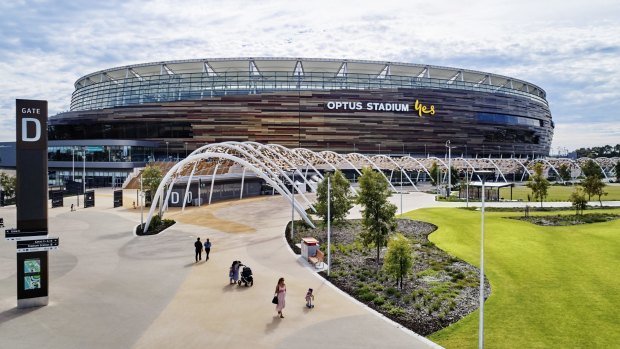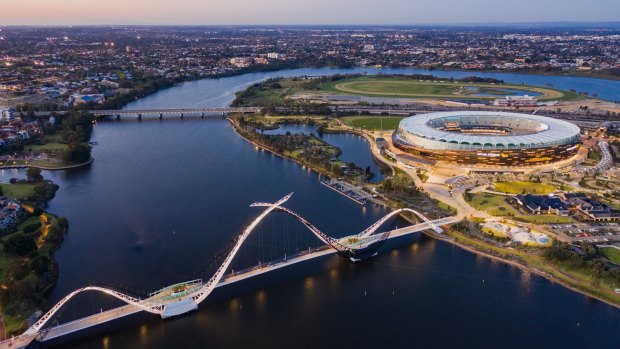This was published 1 year ago
Indigenous tours in Perth: The ancient history of the land Optus Stadium sits on

Optus Stadium's exterior design makes it look like a swan's nest – it's supposed to blend into its surroundings.Credit: Tourism Western Australa
Nick Abraham remembers playing as a kid on this riverbank in eastern Perth, even though he wasn't supposed to. This outcrop of land, bordered on three sides by the sparkling Swan River, was a heavy industrial zone, and then a rubbish dump - a dangerous place for a child to be wandering with his mates.
Still, he remembers swimming in the river over by the old power station, before crossing to Burswood Peninsula and exploring. This is the land of the Whadjuk Noongar People, Nick says, traditional and ancient, a burial ground, a place of great importance, and that connection was never lost, even while it was being used to dump refuse.
He tells me this while we stand on the riverbank at Burswood and let the smoke from burning gum leaves waft past us, a ceremony to clear any negative energy. A group of cyclists sails past on a concrete pathway nearby. Birds chirp in trees. Children laugh in a playground.

Optus Stadium is bordered by the Swan River.Credit: Tourism Western Australia
Behind us lies the silent hulk of Optus Stadium, the 60,000-seat sporting arena that now plays such a huge role in Perth's modern culture.
This is what has become of this important piece of Noongar land. It's a sporting precinct, designed after consultation with Nick and other Noongar members. That process wasn't perfect, given the West Australian government's decision to extinguish native title on the site, but it is a collaborative effort, after local elders advised the area's designers to bring back local flora and fauna to restore the area's desirability.
Nick now hosts tours of the Burswood area with his company, Warrang-Bridil. It's a very different experience being here, to stand in the stadium's shadow and talk about the Indigenous heritage of the land it stands on. It gives context to place; it gives meaning to country.
It also allows you to notice things, like the fact Optus Stadium's exterior design makes it look like a swan's nest – it's supposed to blend into its surroundings, Nick explains, to be hidden in plain sight, just like its inspiration. You notice the words in Noongar language etched into the stadium's walls. You realise the significance of the statue of Nicky Winmar, one of the AFL's true greats, captured in that iconic pose, lifting his jumper and pointing to his skin, on the lawn outside.
A footy stadium without a game on is a strange thing, an empty shell, a husk of a thing with no point. The idea here is to give Optus Stadium a purpose even when the Eagles and the Dockers aren't playing, when the grounds fall silent and the seats are empty.
The Warrang-Bridil tours are just some of the activities that take place here on non-game-days. For those after a little more adrenalin there's also the Ozone, a series of experiences within the stadium itself, most set high up in its rafters.
Visitors can take a standard tour of the stadium, or a "Halo" tour along the walkway that encircles the rooftop, or do what I'm doing, "Vertigo", a walk along a U-shaped platform that hangs a dizzying 42 metres above the bright green playing surface. There's no handrail – you're tethered by industrial climbing equipment to a bar running above, but that means very little to you when you're teetering so high over the ground.
Just next to the stadium is the new Matargarup Bridge, a pedestrian walkway named with the Noongar word for this part of the Swan River, a shallow area known for thousands of years as an ideal crossing point. These days it's spanned by a suspension bridge designed to look like – you guessed it – two swans.
You can just walk across Matagarup. Or, you can climb its metal spires and stand on a platform 35 metres above the water, before zip-lining at 75km/h down to the riverbank. That's what I'm supposed to do today; only, as my group begins the climb a huge storm rolls in, lightning strikes begin in the area, and we're forced to retreat to shelter and safety.
Noongar country still demands respect.
THE DETAILS
VISIT
Warrang-Bridil's 60-minute Ancient Gateway to a Modern City tours run regularly; book at warrang-bridil.com.au Vertigo tours are available most days; see theozone.com.au Matagarup Zip+Climb is open daily; zipclimb.com.au
MORE
Ben Groundwater was a guest of Tourism Western Australia.
Sign up for the Traveller Deals newsletter
Get exclusive travel deals delivered straight to your inbox. Sign up now.